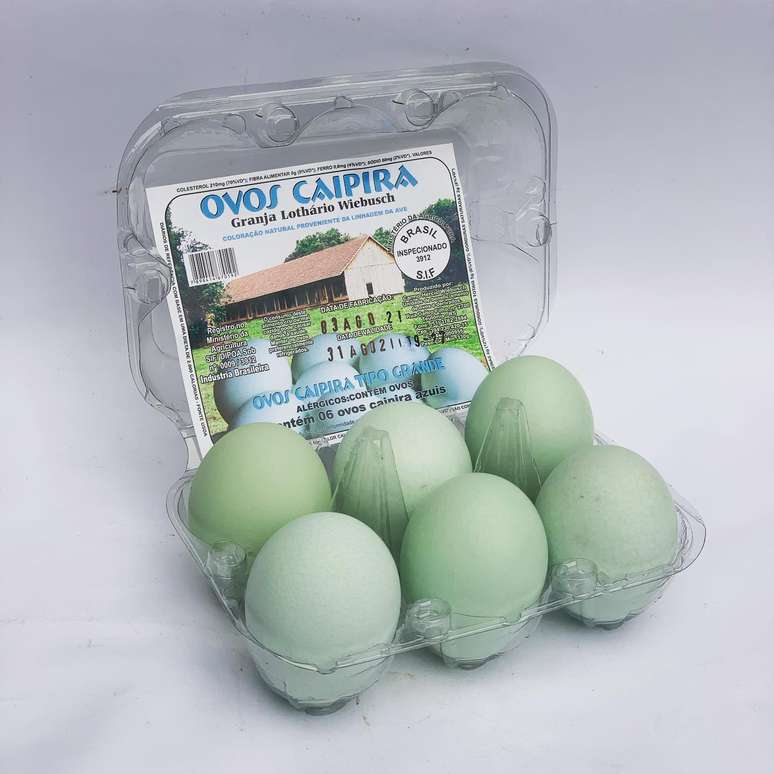The nutritionist explains the difference and reveals whether any color offers greater health benefits
There are many egg options on supermarket shelves: from free-range, organic, farmed and even in different colors: white, blue, red… After all, is there a difference between them? Which is the best to consume?
Considered a complete food for humans, all types are nutritious, the difference being in the breed and color of the chicken’s feathers. Those that are brown in color produce reddish or brown eggs. Those with light feathers have white eggs. Some chicken breeds with grayish and brown fluff may also have bluish or greenish eggs.
The Araucana, originally from Chile, lays blue eggs and the Azur breed is a lineage of birds of French origin, created by an animal breeding company with hens that lay eggs exclusively of that color. It is defined as a hybrid, as it has undergone genetic improvement to possess its current characteristics.
“Initially, all eggs are white and acquire color as they pass through the hen’s oviduct, which is the tubular organ that connects the bird’s ovary to the cloaca, the cavity through which the egg comes out. shell is formed in the uterus, in the so-called shell gland and, almost at the end of the process, a pigment is released that colors it. When there are high concentrations of this substance, called ovoporphyrin, we obtain, for example, red eggs”, explains nutritionist Durval Ribas Filho, president of ABRAN (Brazilian Association of Nutrology).

Furthermore, a study in the scientific journal Nature, Ecology and Evolution, published by Superinteressante, found that the climate of the birds’ habitat influences the color of their eggs.
The researchers concluded that birds in warmer regions lay lighter eggs, while colder regions have darker eggs. The study suggests that the shell’s shade helps preserve temperature.
The dark shade can absorb little sunlight and, consequently, heat, protecting the egg longer. In warm places it is not necessary to absorb as much heat, which is why the shades vary from light to brown.
There is no nutritional difference
From a nutritional point of view there is no difference between white and red eggs, both are equally rich in proteins, vitamins and minerals. The color of the egg yolk is related to the chicken’s diet.
“However, in terms of health benefits, they have the same amount of proteins, vitamins and minerals. What may vary is the size,” says the nutritionist.
Free-range eggs are named for the more natural creation of chickens, which are not trapped in cages and have more space to roam, as well as having a different diet that does not directly interfere with their growth.
Organic eggs come from free-range chicken farms on a diet limited to organic, GMO-free ingredients.
Rich in vitamins A and E, B vitamins, as well as minerals such as selenium, zinc, calcium and phosphorus, eggs offer numerous health benefits, such as preventing diabetes and cardiovascular disease and reducing the risk of osteoporosis.
“Because they contain a significant amount of antioxidants, compounds that fight free radicals, eggs help prevent premature aging. And, because they are rich in protein, they also aid in muscle production, encouraging muscle mass gain,” he says the doctor.
Optimal quantity
Regarding the amount of egg consumption, Durval Filho states that this topic has been modified with scientific evidence. “Currently, consumption recommendations vary, but in general eating up to 14 eggs per week (2 per day) is considered safe for most people,” he says.
Eggs are contraindicated in case of allergy to albumin, which is the protein present in egg white.
How to choose eggs at the supermarket?
When choosing the best product to consume, the professional warns that an essential precaution is to avoid eggs with damaged shells.
“The presence of cracks or closures can pose health risks. It is also important to give priority to those that have certification seals, such as that of the Federal Inspection Service (SIF) and the Ministry of Agriculture (MAPA), for example Always observe the production date and shelf life of the product, as it is a very perishable food”, he advises.
Egg care must also be maintained at home and during preparation:
– Do not wash the shell to avoid removing the protective film.
– They must be stored in the refrigerator, preferably in the original packaging.
– Do not leave them on the refrigerator door, since in this space there is a thermal variation which can increase the risk of food contamination.

10 vegetable milks for lactose intolerants
Source: Terra
Ben Stock is a lifestyle journalist and author at Gossipify. He writes about topics such as health, wellness, travel, food and home decor. He provides practical advice and inspiration to improve well-being, keeps readers up to date with latest lifestyle news and trends, known for his engaging writing style, in-depth analysis and unique perspectives.

-1hr8nyj7nubmr.jpg)






